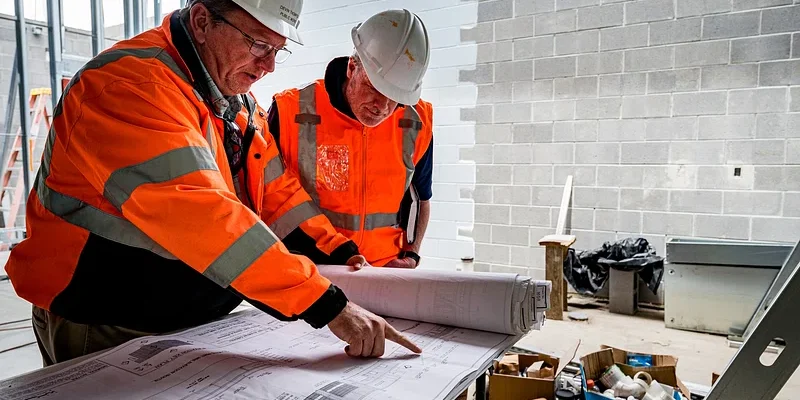“A culture of caring is a direct reflection of how much companies value their team members, and those team members perform at a high level because they know they’re part of a company that wants to see them succeed both personally and professionally,” –Aimee Comer, vice president of people and development, Robins & Morton.
Like the rest of the world, the construction industry has been hit hard by the ongoing labor shortage. With people aging out of the workforce, the lack of skills training, the societal push for a four-year college education, and the creation of jobs outpacing the number of job seekers, there simply aren’t enough people to fill the gaps. The COVID-19 pandemic exacerbated this worker shortage, as older generations decided to retire early or companies were unable to replace employees who passed away during the pandemic. Although the shortage may seem like a global catastrophe, solutions are in sight, even for the construction industry, which is experiencing record gaps in its workforce. Companies are aware of steps that must be taken to actively recruit new employees and retain current ones.
Alabama Construction News reached out to three human resources experts in the field to discuss these strategies.
Offering Quality Benefits
One of the main things that motivate potential new employees, as stated by all interviewed human resources experts, is a rich benefits package. Benefits such as better pay, high-quality insurance plans, and flexible PTO are top incentives for the incoming workforce. According to Stephanie O’Melia, vice president of human resources, safety, and risk management at Dunn Building Company, money is the most important way to attract people to work for your company. Dunn has demonstrated this by raising wages multiple times in recent years due to the lack of skilled craftspeople and the overall labor shortage. “You’re just going to have to pay them more and also offer better benefits because the type of people specifically [who] we’re looking for are family-oriented,” O’Melia said. She further explained that workers need higher wages to provide for their families. O’Melia also noted higher turnover among field workers, such as craftspeople working on job sites: “As a company, you got to really look at trying to make those wages and those benefits as attractive as possible to keep your current craft.”
Robins & Morton Vice President of People and Development Aimee Comer agreed that rich benefits packages are critical in attracting and retaining talent. She said that one way the Birmingham-based company differentiates itself is by offering benefits aligned with its workforce’s unique needs. In addition to excellent health care and 100 percent company-paid vision and dental insurance, Robins & Morton offers services requested by their team members, such as virtual physical therapy, pet insurance, virtual teletherapy, and a diabetes management program. Providing flexible vacation time for employees is also key, as it allows workers to spend time with their families and prevent burnout. “PTO has become one of the main currencies of employees today,” said David Salters, practice leader of HR solutions at Warren Averett. Generous PTO and schedule flexibility for both office and onsite workers are crucial. Job sites have more inconsistent work hours than office settings, so allowing field employees to collaborate with management to adjust their schedules creates a flexible and appealing workplace.
Training Programs
One of the many reasons younger people struggle to find work in the construction industry is their lack of experience. Professionals recognize this; recently, lack of experience no longer means not getting hired in the field. On-site training and workforce development have become commonplace in the construction industry in the last couple of years. An example of this is ABC of Alabama’s Academy of Craft Training, which provides high school students with experience in the trades. Multiple ABC of Alabama members work with the Academy to help prepare the next generation for the construction industry. “We hire from their graduates every year knowing that they don’t have all the experience that we need, knowing that they don’t have all the training that we need, but we’re willing to … invest in them and give them the training that they require to do the jobs that we need them to do,” O’Melia said. “I think that’s something that the industry as a whole [is] going to have to do — invest more into training those who are unskilled or under-skilled to fill these gaps that we have.”
“A lot of [craftspeople] want to know that they have a future with your company, so they’re looking for growth opportunities. I think just having a plan and being able to show your workers that if they stick with you, you will invest in them and develop them to be the future leaders of the company. Assisting younger employees with developing career plans will inform them they have a future — and a purpose — in the company and the industry as a whole,” said O’Melia.
In addition to the Academy of Craft Training, Robins & Morton engages with many organizations in Alabama, such as Auburn University’s McWhorter School of Building Science’s Summer Construction Academy for Young Women, to inform young people of the benefits of having a career in construction. “Our goal is to simply encourage the next generation to pursue careers in construction, and that effort begins within our communities,” Comer explained. The company additionally hires individuals with strong leadership skills, even if they don’t have previous experience in construction, such as military veterans. “We know that if we hire good people who are strong leaders, we can overcome some of the hard skill gaps when the soft skills are in place,” she said. Once these folks are hired, they are encouraged to work with the company’s Learning and Career Development team, which provides staff members support in identifying and pursuing goals, both personal and professional. Nearly 150 live classes are offered through this program each year, in addition to a library of more than 3,000 on-demand training opportunities.
Salters also suggested recruiting older generations back into the workforce to assist with training new hires. According to the Bureau of Labor Statistics, the labor force participation rate for workers ages 55 and older is very low; this age range consists of several early retirees, and this is where many skilled trades reside in the industry, explained Salters. Reaching out and giving them a “mission” to pass their knowledge down to younger generations would be an effective tactic. “Most of those workers likely are not solely incentivized by a 9-to-5 job. Most cases, they probably don’t want to work 40 hours a week, but they should be paid what they’re worth in the current market value. … They would probably take a lot of pride in helping train the next generation. That would be their mission, versus just coming in and clocking in and out.”
Career Advancement
Now that a new hire is employed at your company, incentivizing them to stay long-term is crucial. According to a poll conducted by Monster, 54 percent of respondents had quit a job less than six months after they started, so those early months are vital for new hires. For younger generations such as Gen Z and Gen A, gaining experience with training and mentorships on the job is important, but what is probably even more effective is letting them know they can build a career in this industry. “A lot of [craftspeople] want to know that they have a future with your company, so they’re looking for growth opportunities,” O’Melia explained. “I think just having a plan and being able to show your workers that if they stick with you, you will invest in them and develop them to be the future leaders of the company.” Assisting younger employees with developing career plans will inform them they have a future — and a purpose — in the company and the industry as a whole. “Our Robins & Morton team members know that they’re contributing to something greater than themselves, which gives them purpose in their work,” Comer added. “Their ability to have a meaningful career, see the impact that they have, and take care of themselves and their families makes a tangible difference in their lives. Construction offers a unique opportunity to career seekers, and helping team members recognize the opportunities available to them is essential.”
In the same vein as developing the incoming workforce, developing your management staff is just as important, according to Salters. Due to the labor shortage and the inability to fill open management positions, employees are being promoted prematurely into these positions without receiving proper training and guidance. This means they aren’t equipped to lead their teams — which, Salters said, contributes to the old adage that people don’t quit their jobs, they quit their bosses. “Building really great leadership teams, middle management teams, and supervisory teams is a great way to retain your staff,” he said.
Company Culture
Inclusive and welcoming company cultures are also key to keeping team members on board. “I always recommend looking internally first and focusing on culture. Being a good employer that values team members makes companies much more likely to attract and retain talent,” Comer explained. Once people join the Robins & Morton team, they are introduced to the company’s Building Forward® approach, which represents their commitment to progressing everything they do through four tenets: collaboration, continuous improvement, leadership development, and creating a learning culture. Allowing employees the opportunity to provide feedback, whether it be related to the job itself or company initiatives, will allow the company to grow and improve. “Through team member satisfaction surveys and one-on-one conversations, we hear that [the Building Forward®] approach makes a tremendous difference in their team member experience,” she said. Another way to improve company culture is to reexamine why former employees left in the first place. “When you do lose someone … find out why they left so you’re looking for trends and then reading your employee data,” Salters said. This can help raise awareness if your company is experiencing high turnover at a certain location. Conducting exit interviews and evaluating leadership are effective ways to gauge why employees are leaving specific office locations and job sites. After gathering your findings, address these to improve culture companywide. Also, while reviewing the negatives is important,
it is also good to look at the positives. Look for areas that have low turnover, and see if you can model the best practices from those groups and apply them across your organization.
Conclusion
Searching for the perfect applicant — and making them a long-term employee at your company — requires a lot of time and resources, especially amid the ongoing labor shortage. However, incentivizing your workforce with quality benefits, such as flexible PTO and on-site training, will encourage them to apply to, and eventually work for, your company. Retaining your workforce is crucial too, as hiring a new employee can cost up to three times to four times the position’s salary. Providing your team with the tools and training to advance in their careers, as well as examining your company’s culture, are just the tip of the iceberg. Think outside the box and examine your company’s best practices to tackle the ongoing labor shortage and figure out what works best for your company and your employees.
Try active recruitment
There are approximately 9 million to 10 million open jobs in the U.S. job market and not enough employees to fill those positions. Traditional methods like simply posting on job boards or your company’s website typically will not be enough. David Salters, practice leader of HR solutions at Warren Averett, also runs his own professional recruiting and HR consulting firm, and he said active recruiting is the most effective way for employers to fill the open positions at their company. His suggestions include:
- Reach out to well-suited passive candidates, or candidates who are already employed elsewhere and aren’t looking for work. According to LinkedIn, this group accounts for 75 percent of the workforce.
- Use your internal workforce as your advocate and implement an employee referral program.
- Offer incentives to employees who recommend candidates for open job positions.
- Get involved with student training programs like ABC of Alabama’s Academy of Craft Training. With more people contributing to the Academy, more students can be funded to participate in the program and will eventually join the construction workforce.













